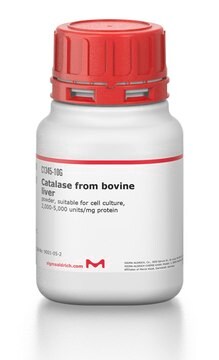04529
Nitrilase
recombinant, expressed in E. coli, ≥2.0 U/mg
Synonym(s):
Nitrile aminohydrolase
Sign Into View Organizational & Contract Pricing
All Photos(1)
About This Item
CAS Number:
MDL number:
UNSPSC Code:
12352204
NACRES:
NA.54
Recommended Products
recombinant
expressed in E. coli
form
crystals
powder
specific activity
≥2.0 U/mg
mol wt
41 kDa
storage temp.
2-8°C
General description
Nitrilase belongs to the C-N hydrolase superfamily. It possesses the catalytic triad motifs: glutamate, lysine, and cysteine and are distributed in fungi, plants, and animals.The isoelectric point (pI) of this protein is 8.1. Native polyacrylamide gel electrophoresis (PAGE).
Application
Nitrilase may be used for immobilization on acryloyl crosslinked cellulose dialdehyde (ACCD) for catalytic activity studies.
Biochem/physiol Actions
Nitrilases catalyze the liberation of ammonia and the formation of carboxylic acid from the nitriles. The oligomeric structural organization of nitrilase is crucial for its functionality. It displays broad substrate specificity.
Packaging
Bottomless glass bottle. Contents are inside inserted fused cone.
Unit Definition
1 U corresponds to the amount of enzyme which liberates 1 μmol ammonia per minute at pH 7.2 and 25°C with the conversion of acrylonitrile to acrylic acid
Signal Word
Danger
Hazard Statements
Precautionary Statements
Hazard Classifications
Resp. Sens. 1 - Skin Sens. 1
Storage Class Code
11 - Combustible Solids
WGK
WGK 3
Flash Point(F)
Not applicable
Flash Point(C)
Not applicable
Choose from one of the most recent versions:
Already Own This Product?
Find documentation for the products that you have recently purchased in the Document Library.
Alena Petříčková et al.
Applied microbiology and biotechnology, 93(4), 1553-1561 (2011-09-06)
Nitrilases from Aspergillus niger CBS 513.88, A. niger K10, Gibberella moniliformis, Neurospora crassa OR74A, and Penicillium marneffei ATCC 18224 were expressed in Escherichia coli BL21-Gold (DE3) after IPTG induction. N. crassa nitrilase exhibited the highest yield of 69,000 U L(-1)
Einar J Stauber et al.
PloS one, 7(4), e35545-e35545 (2012-04-27)
Plants have evolved a variety of mechanisms for dealing with insect herbivory among which chemical defense through secondary metabolites plays a prominent role. Physiological, behavioural and sensorical adaptations to these chemicals provide herbivores with selective advantages allowing them to diversify
Chen-Sheng Zhang et al.
Applied microbiology and biotechnology, 95(1), 91-99 (2012-03-29)
(R)-o-Chloromandelic acid is the key precursor for the synthesis of Clopidogrel®, a best-selling cardiovascular drug. Although nitrilases are often used as an efficient tool in the production of α-hydroxy acids, there is no practical nitrilase specifically developed for (R)-o-chloromandelic acid.
Shivani Jamwal et al.
International journal of biological macromolecules, 131, 117-126 (2019-03-08)
Immobilization of enzymes to improve their catalytic properties is an attractive protocol which makes them suitable candidates to meet various industrial demands. Present study describes the synthesis of new acryloyl crosslinked cellulose dialdehyde (ACCD) for nitrilase immobilization. Nitrilase was immobilized
Joanna E Raczynska et al.
Journal of structural biology, 173(2), 294-302 (2010-11-26)
The nitrilase superfamily is a large and diverse superfamily of enzymes that catalyse the cleavage of various types of carbon-nitrogen bonds using a Cys-Glu-Lys catalytic triad. Thermoactive nitrilase from Pyrococcus abyssi (PaNit) hydrolyses small aliphatic nitriles like fumaro- and malononitryl.
Our team of scientists has experience in all areas of research including Life Science, Material Science, Chemical Synthesis, Chromatography, Analytical and many others.
Contact Technical Service









